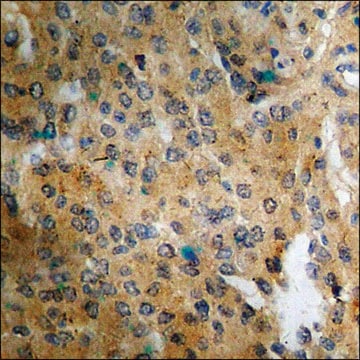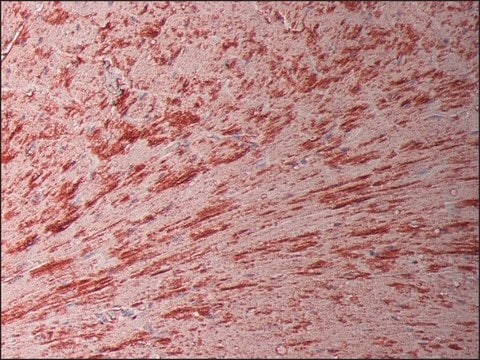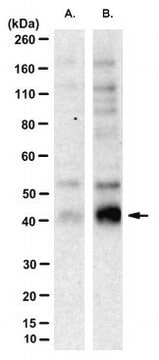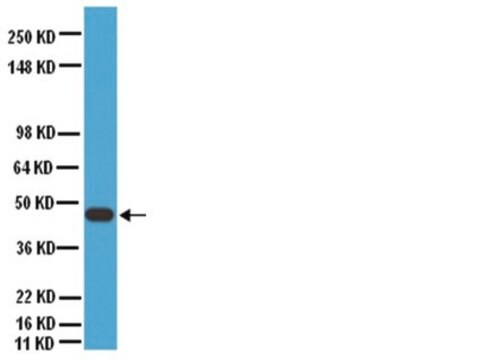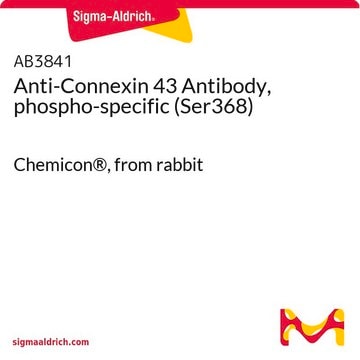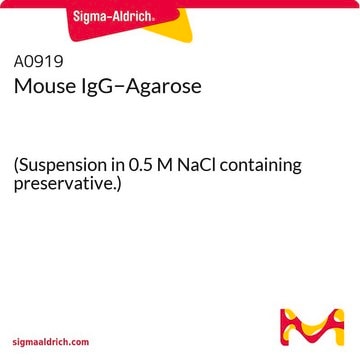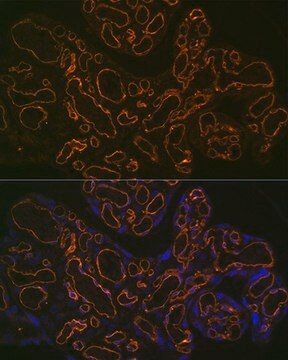MAB3067
Anti-Connexin 43 Antibody, clone 4E6.2
clone 4E6.2, Chemicon®, from mouse
Synonym(e):
Gap junction 43 kDa heart protein, connexin 43, gap junction protein, alpha 1, 43kDa, gap junction protein, alpha 1, 43kDa (connexin 43), gap junction protein, alpha-like
About This Item
Empfohlene Produkte
Biologische Quelle
mouse
Qualitätsniveau
Antikörperform
purified immunoglobulin
Antikörper-Produkttyp
primary antibodies
Klon
4E6.2, monoclonal
Speziesreaktivität
mouse, rat, pig, canine
Speziesreaktivität (Voraussage durch Homologie)
human
Hersteller/Markenname
Chemicon®
Methode(n)
ELISA: suitable
immunocytochemistry: suitable
immunohistochemistry: suitable
western blot: suitable
Isotyp
IgG1
NCBI-Hinterlegungsnummer
UniProt-Hinterlegungsnummer
Versandbedingung
wet ice
Posttranslationale Modifikation Target
unmodified
Angaben zum Gen
human ... GJA1(2697)
Allgemeine Beschreibung
Spezifität
Immunogen
Anwendung
Zellstruktur
Adhäsions-Proteine (CAMs – Zelladhäsionsmoleküle)
1:1000-10,000 freshly prepared lysates, proteinase inhibitors are recommended. Recognizes proteins of molecular weight 43-47 kDa on Western blots of mouse brain lysate.
Immunocytochemistry:
A 1:50-1:250 dilution of a previous lot was used in immunocytochemistry.
Immunohistochemistry:
A previous lot was used to detect Connexin 43 expression in the keratinocytes of the middle and upper epidermal layers of frozen human skin tissue (Arita, Ken, et al. (2006). Am. J. Pathol. 169:416-423).
Immunohistochemistry:
A previous lot was used to detect Connexin 43 expression in human and rat heart tissue (1:500 dilution).
ELISA:
A previous lot of this antibody was used in ELISA.
Optimal working dilutions must be determined by end user.
Qualität
Western Blot Analysis:
1:1000 dilution of this antibody detected Connexin 43 on 10 μg of rat brain lysates
Zielbeschreibung
Physikalische Form
Lagerung und Haltbarkeit
Hinweis zur Analyse
Mouse brain tissue lysate
Sonstige Hinweise
Rechtliche Hinweise
Haftungsausschluss
Not finding the right product?
Try our Produkt-Auswahlhilfe.
Empfehlung
Lagerklassenschlüssel
12 - Non Combustible Liquids
WGK
WGK 2
Flammpunkt (°F)
Not applicable
Flammpunkt (°C)
Not applicable
Analysenzertifikate (COA)
Suchen Sie nach Analysenzertifikate (COA), indem Sie die Lot-/Chargennummer des Produkts eingeben. Lot- und Chargennummern sind auf dem Produktetikett hinter den Wörtern ‘Lot’ oder ‘Batch’ (Lot oder Charge) zu finden.
Besitzen Sie dieses Produkt bereits?
In der Dokumentenbibliothek finden Sie die Dokumentation zu den Produkten, die Sie kürzlich erworben haben.
Unser Team von Wissenschaftlern verfügt über Erfahrung in allen Forschungsbereichen einschließlich Life Science, Materialwissenschaften, chemischer Synthese, Chromatographie, Analytik und vielen mehr..
Setzen Sie sich mit dem technischen Dienst in Verbindung.